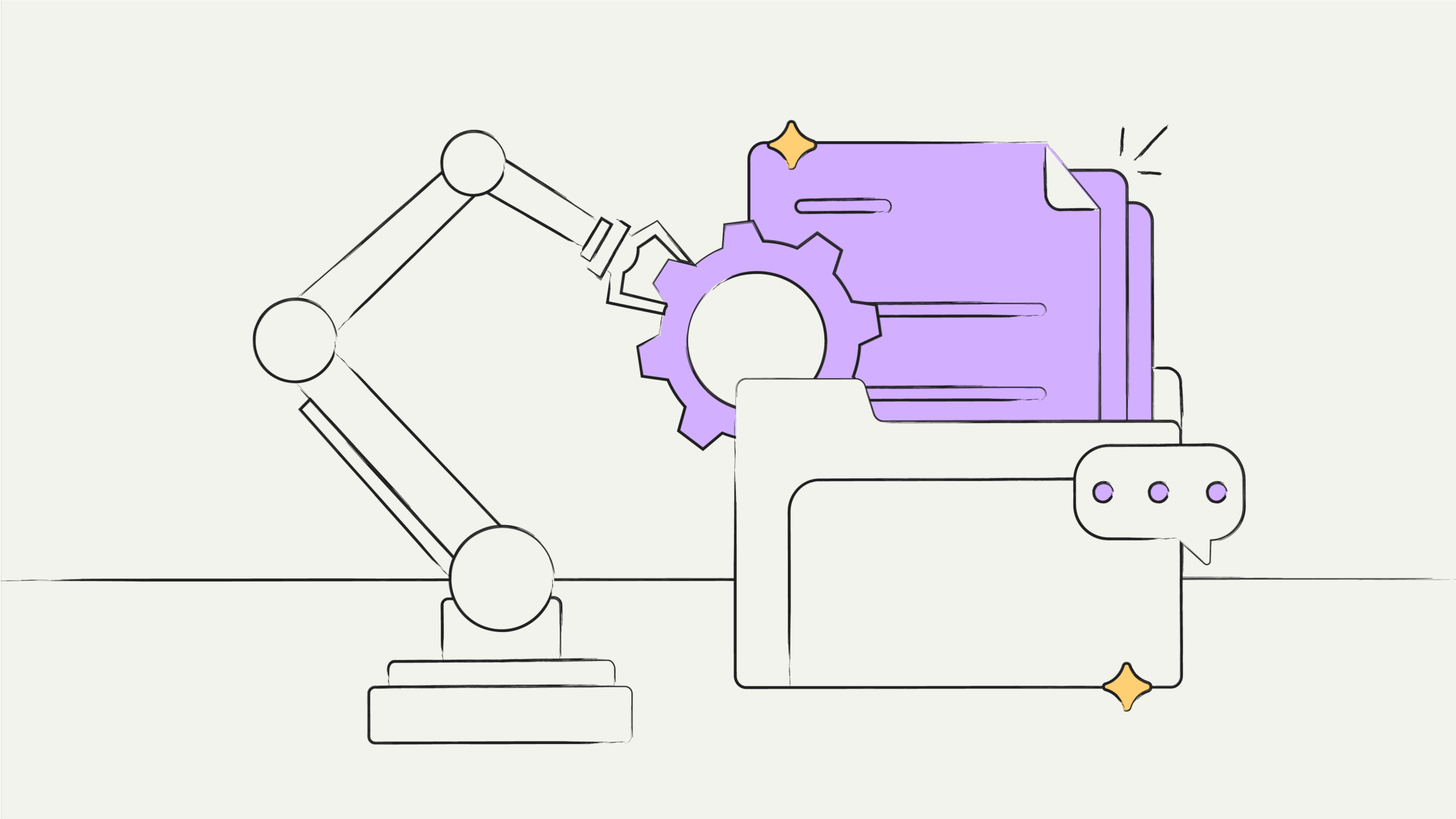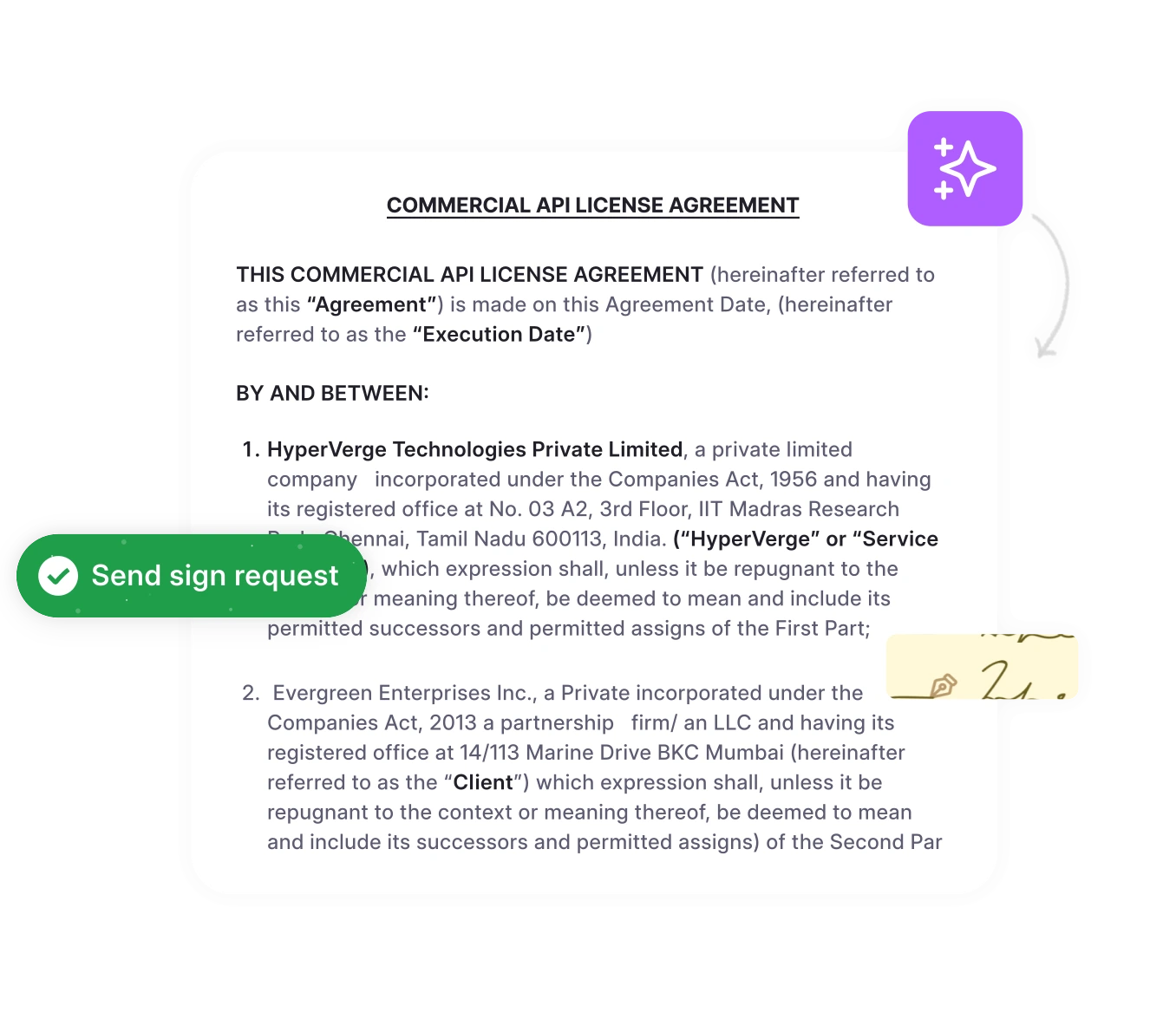Drafting contracts can be one of the most time-consuming and resource-intensive tasks for legal and business teams. Errors, inconsistencies, and outdated language often slip through, leading to compliance risks and costly delays.
In fast-paced industries, these issues can slow down deals, strain client relationships, and overwhelm legal departments already stretched thin.
Automated contract drafting is emerging as a solution to this pressing challenge, helping companies generate accurate, compliant contracts in record time. By leveraging AI-driven automation, teams can streamline contract creation, reduce errors, and focus on higher-value work.
In this blog post, we’ll learn how automated contract drafting works and why it’s so helpful for legal teams.
What is automated contract drafting?
Automated contract drafting is the process of using software, often powered by AI and machine learning, to create contracts quickly and accurately based on pre-set templates and rules.
As per a report by Thomson Reuters Institute, one of the top uses of ChatGPT and Generative AI technologies in legal and corporate is in contract drafting (76%).
Instead of drafting each contract from scratch, legal and business teams can use automated tools to fill in standard clauses, terms, and variables, adapting the language based on factors like contract type, party details, or jurisdiction. This approach minimizes human error, enhances consistency, and significantly reduces drafting time.
What are the challenges of traditional contract drafting?
Traditional contract drafting faces numerous challenges that can hinder efficiency, compliance, and overall effectiveness in managing agreements. Here are the primary issues associated with this outdated approach:
1. Siloed data and lack of visibility
Contracts are often stored in various locations—paper files, emails, and personal drives—leading to information silos. This fragmentation makes it difficult to track obligations and deadlines, resulting in missed opportunities and potential legal risks. Many organizations struggle to locate all their contracts, complicating compliance and oversight.
2. Inflexible and time-consuming processes
The manual nature of traditional contract drafting is inherently slow and prone to errors. Processes such as drafting, negotiating, and approving contracts can take significant time, diverting resources from core business activities. Legal departments often find themselves bogged down by inefficient workflows that delay contract execution.
3. Non-compliance and risk management issues
Manual tracking of contractual obligations increases the risk of non-compliance with legal requirements. This lack of oversight can lead to costly penalties or disputes over contract terms. Additionally, the inability to effectively identify and mitigate risks associated with contracts can expose organizations to significant financial liabilities.
4. Inefficient search and analysis
Finding specific clauses or obligations within a large volume of contracts is cumbersome when using traditional methods. The absence of a centralized database means extracting insights from contracts is labor-intensive and often inaccurate. This inefficiency can delay decision-making processes and hinder strategic planning.
5. Limited scalability and collaboration
As businesses grow, the volume of contracts typically increases. Traditional systems struggle to manage this growth effectively, making it difficult for teams across departments to collaborate on contracts. Without streamlined communication channels, the approval process can become a bottleneck, further complicating contract management efforts.
6. Poor drafting practices
Traditional drafting often relies on outdated templates or inconsistent language, leading to misunderstandings and potential legal disputes. Many drafts are created without adherence to established guidelines, resulting in unclear or redundant clauses that complicate agreements unnecessarily. The reliance on “copy-and-paste” methods contributes to a lack of clarity in contracts, making them harder for all parties to understand.
7. Resistance to technological adoption
Despite the availability of advanced contract management solutions that could alleviate many of these challenges, many organizations remain hesitant to adopt new technologies. Factors such as budget constraints, resistance to change, and a lack of awareness about the benefits of automation hinder progress toward more efficient contract management practices.
Who benefits from automated contract drafting and how?
Automated contract drafting provides significant advantages for enterprises, small businesses, startups, and solopreneurs, helping to boost productivity and save resources by streamlining the contract creation workflow. This is particularly transformative for various departments across organizations, each with specific KPIs and deliverables within their scope of work.
1. Legal teams
Automated contract drafting is a game-changer for legal teams. AI-powered legal contract drafting software can generate contracts in minutes, incorporating chameleon clauses and automatic styling for consistency. With tools designed to enhance negotiation capabilities, in-house legal teams can utilize pre-approved clause libraries and templates that ensure compliance and efficiency. This approach can reclaim up to 80% of legal operations efficiency by:
Reducing time spent on drafting: Contracts are created quickly, eliminating the need to scroll through extensive paperwork to find definitions or errors.
Streamlining legal tasks: Contract management software automates not just contract drafting but also document review, compliance checks, and case management.
Enhancing strategic focus: Legal resources can be redirected toward more strategic tasks such as risk assessment, negotiations, and advisory roles, as compliance checks and approval workflows minimize errors and omissions.
Apart from contract drafting the CLM software can help to automate other legal tasks such as contract creation, document review, compliance checks, and case management.
2. Non-legal teams
Non-legal departments such as sales, HR, procurement, and finance also benefit immensely from automated contract drafting. The CLM process becomes more collaborative, guided, and intuitive, enabling different teams to take ownership of generating routine agreements without relying heavily on legal support. This not only reduces costs associated with legal operations but also enhances employee morale and productivity. Key benefits include:
Sales Teams: Automated contract drafting enables faster turnaround times (TAT) for contracts, allowing sales teams to close deals more quickly and improve customer satisfaction scores.
Procurement Teams: Automation ensures consistency and accuracy in vendor contracts, fostering better supplier relationships, which can lead to more favorable terms, reduced costs, and enhanced collaboration.
Human Resources Teams: HR can process standard employee contracts in bulk, streamlining recruitment and onboarding processes while minimizing paperwork.
Finance Teams: Automated drafting incorporates built-in compliance checks and mandated guardrails, leading to better contract risk management and improved cash flow.
Automate Your Contract Drafting Today
Reduce drafting time and focus on real opportunities instead of routine paperwork. Get started with HyperStart and see the difference.
Book a Demo8 Essential features to automate your contract drafting

Contract drafting comprises crucial milestones that make sure an agreement is comprehensive, legally binding, compliant, and mutually beneficial for each party involved. Automating rote work along this process empowers the whole organization and counterparties with contracting structure and velocity. HyperStart AI-based contract management software offers a single comprehensive set of contract drafting tools to elevate your drafting experience through automation:
1. Template library
Pre-approved templates are dynamic digital assets that help you repurpose standard form agreements. There is no need to recreate the wheel for similar agreements, saving valuable time and resources.
2. Clause recommendations
Clauses function as legos to ensure consistency in terminology, grammar, style, cross-referencing, contracting policies, and other elements. They are designed to adapt to different environments and the library is built to be a shared brain of standardized clauses.
3. AI drafting
Assisted drafting allows users to draft and redraft clauses and documents with case-specific prompts and query contracts for key information. While AI-powered tweaking updates contractual language autonomously, it still requires human supervision.
4. Version control and counterparty access
A clear audit trail with version control features allows you to track changes and revisit previous versions if necessary while making sure each party involved is working with the current iteration of the agreement. HyperStart also offers secure counterparty access for faster review.
5. MS Word plugin
Eliminate switching between tabs and applications with automated templates directly from a browser-native MS Word plugin. This functionality is both familiar and simplified for automated contract generation.
6. Intake forms
The intake forms automate contract creation, making it much simpler and more efficient for employees, vendors, and suppliers to create a wide range of contracts like NDAs, MSAs, employee agreements, order forms, and so on. It empowers non-legal professionals to initiate routine contract requests and gather information.
7. Conditional rules
Conditional rules add another layer of automation. They dynamically adjust the contract based on the input, populating relevant clauses and sections based on specific form responses.
8. Bulk contract creation
High volumes of standard contracts can be initiated, processed, sent, and tracked with bulk actions. Bulk contract creation is a handy tool for HR and procurement teams that deal with multiple contracts, allowing them to pre-populate data and save significant time and effort.
What are the tech drivers behind automated contract drafting?

Artificial intelligence and machine learning
Natural language processing (NLP): NLP parses through complex legal texts, identifies key clauses, analyzes them, and suggests appropriate clauses based on pre-approved rules and standardized templates.
Predictive analytics: Machine learning models analyze a centralized repository to spot contract risks and predict outcomes and performance based on key clauses or non-compliance.
Intelligent document automation: This system automatically populates templates with key clauses, making them dynamic to fit specific contract requirements.
These elements together form a comprehensive contract intelligence system that enhances the efficiency, accuracy, and effectiveness of contract management.
Cloud Solutions & Integrations
Cloud computing: Cloud-based CLM platforms ensure that all contract data is securely stored and backed up. The systems can be accessed and scaled safely from anywhere for better collaboration among distributed or remote teams.
Integrations: Cloud-based CLM systems integrate with other business applications like CRM, ERP, and HRMS for frictionless data flow and alignment with other business processes.
Robotic process automation (RPA)
Automating repetitive tasks: This technology uses contract drafting software bots to automate duplicative, rule-based tasks, reducing the drafting time frame and manual errors. This is best for mundane work like data entry, contract formatting, and compliance audits so legal professionals can focus on more meaningful work.
Workflow automation: RPA also streamlines the workflow by automating routine contracts for review without delays or bottlenecks.
Process analytics and reporting
Dashboard insights: Key metrics like contract cycle times, approval times, time taken for review, and compliance rates can be tracked to continually optimize the contract process. A custom in-flight dashboard can offer real-time visibility into the contracting process and status to make sure KPIs are met.
Security technologies
Data encryption:Advanced encryption methods are crucial to keeping contract data safe in transit and at rest. Robust access controls, multi-factor authentication, and workflow mechanisms must reflect security measures for confidentiality and data integrity.
Why do businesses choose HyperStart to automate contracts?
At HyperStart AI contract drafting software, we work with many legal teams that have significant opportunities to improve their contracting processes. They have an undeniable appetite for better renewal tracking, competitive analytics dashboards, and frictionless pre-execution processes that can help them close deals faster.
See how HyperStart works! 👇
1. AI-powered metadata extraction
As our extractive AI models lead the force of innovation, their 99% accuracy has proved incredibly lucrative and efficient. It performs tasks that would otherwise take weeks and months to manually enter, track, and follow up on in mere minutes. You can automatically track contract expiration dates, liability exposure, and other key obligations. You can also automate reminder alerts to necessary stakeholders about upcoming obligations.
Beyond metadata extraction, HyperStart allows you to redline contracts quickly using AI-powered review and version control. Its intuitive in-app editor or Microsoft Word plug-in helps comment and suggest changes. Recently, HyperStart helped LeadSquared streamline its contract review process. Here is the testimonial of their legal head.
We took demos of around 5 CLM vendors and chose to use HyperStart. They were the only CLM vendor who had SOC2 compliance and met the criteria of around 22 parameters which we had evaluated them on.

Om Prakash Pandey
Head of Legal at LeadSquared
2. Central repository with a powerful search
The repository stores, organizes, and retrieves contracts in one secure, unified space. Bulk import contracts from Gmail, OneDrive, Google Drive, Salesforce CRM, or your local storage. Find the contract data you’re looking for in seconds. These centralized systems of intelligence are meticulously organized, easily searchable with powerful AI, SSO integrated, and end-to-end encrypted. No more file hunts with digital contract repositories.
3. Dashboards & Analytics
Visualizing contract data helps you decrease risk exposure with auto-generated reports. Understand your risk exposure with better contract visibility and avoid contract breach penalties. They help you manage obligations and avoid contractual risks like conflicts, penalties, and termination based on contract type, deadlines, recurrence, and criticality. Visual graphs help visualize critical data for easy consumption. Key functionalities include AI-powered extraction and analysis and proactive notification reminders. Proactive tracking prevents oversight, missed renewals, and contract risks.
4. Security
Legal tech adoption in AI across the world is seeing an uptake. The US and Canada lead the charge with larger conversations on data privacy and cybersecurity despite headwinds in pending regulatory policies, lack of trust, and budgets. HyperStart is hosted on AWS with ISO 27001:2013, and SOC Type 2 compliant standards. Furthermore, you can set granular access to the contracts and define who works on them at which stage. With access control, your contracts are searchable, trackable, and safe.
5. Affordable
HyperStart is a no-brainer choice for many scaling organizations as you save up to 30% on your annual subscription. It is accessible and scalable, offering superior value at a fraction of the cost. You get to save money on consultant fees for set-up and support. You pay for the modules you use with no hidden fees. We’re contour custom pricing to make sure we tailor the solution to your business needs. Besides, you get to realize ROI 75% faster.
Ready to automate your contract drafting?
There is no lack of tech advances in contract drafting. The process can be fully automated with human intervention for a final review. AI automation and augmentation have proven incredibly efficient, performing hours and weeks of work in a few minutes. The landscape has never been this vibrant or crowded. With new product launches every week, it’s increasingly difficult for lawyers to assess which tools will work for them best.
As a product of HyperVerge, we build deep-learning AI engines that have processed 8+ million documents in the past 3 years in 190+ countries across 5 geographies. You can seamlessly import scanned or digital contracts from your inbox, CRM, or drive in minutes. Critical data is auto-extracted with AI and highlighted to repurpose so you can create contracts in 2 minutes.
Transform Your Contract Drafting Process With HyperStart
Generate accurate contracts in just 2 minutes using HyperStart’s dynamic templates and intuitive intake forms.
Book a Demo











